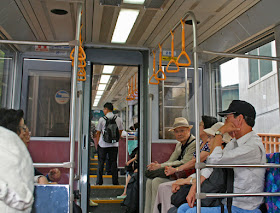Daibutsuden- Great Buddha Hall
|
From Kyoto Station, we took the JR Train to the city of Nara. After a 45-minute trip we arrived in the center of town. It took about an hour to walk to the Nara Deer Park and The Todai-ji along the Higashimuki Shopping Arcade. The crowd of visitors increased as we neared the Temple complex.
It is a wonderful experience to buy deer food and feed the holy Sitka Deer. Remember to bring something to wipe your hands with after feeding them. The deer aren’t the cleanest of animals and our hands were black with dirt.
Nandaimon- Great Southern Gate
|
The Todai-ji (The Eastern Great Temple) in Nara is a large Buddhist complex that contains a number of remarkable historic wooden structures.The centerpiece is the Daibutsuden (The great Buddha hall) that is thought to be the largest wooden structure in the world.The original building was completed in 752CE, but later fell victim to earthquake, fire and warfare.The present building dates from 1709 and is somewhat smaller than the original.
Within the vast 182’ (55.5m) by 160’ (48.75m) interior is an immense bronze seated image of the Buddha of Infinite Light (Vairocana]) begun in 747CE. The statue towers 47’ (14.35m) above its pedestal. Behind is an even larger gilt aura with additional Buddhas. The statue was damaged along with the temple and parts have been replaced at various times.
Because of the immense scale of this building, no single trees were large enough to form the massive columns. In one case, a section of a column was omitted so children or small persons may crawl through to obtain religious merit. Most adults can’t make it though.
After the Daibutsuden, we strolled around seeing the various temple structures and then started back towards Nara Station. We had bowls of Udon in the Higashimuki Arcade on the way back and stopped at several shops selling traditional Nara delicacies, including Sushi, Pickled Vegetables, and other tasty morsels. Having left our Kyoto hotel at around 9:00, we were back at the Kyoto Station at roughly 20:00. Nara City is a great day trip from Kyoto, there’s a lot to see and do. Highly recommended!




















































